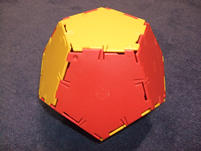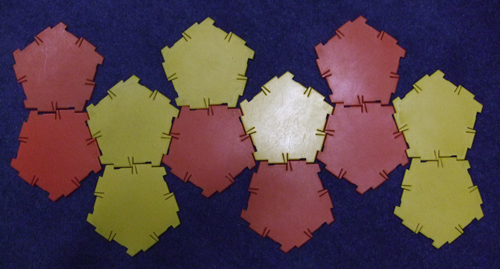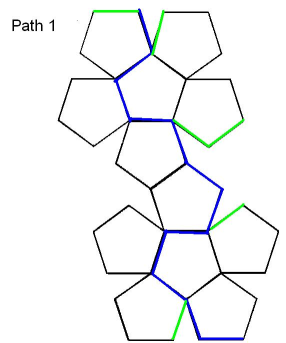Platonic planet
Problem

Glarsynost the alien lives on a platonic planet whose shape is that of a perfect regular dodecahedron.
Every day, she likes to go for a walk to have a look at her planet and see if she has any visitors.
What fraction of the planet's surface can she see from the middle of a face? From an edge? From a vertex?
Her walk needs to start and end at the same place, and she needs to be able to see every part of the planet's surface at some stage during her walk. Investigate the possible paths she could take. The challenge is to find the shortest path you can!
One way of investigating and recording this could be to create a net of a dodecahedron, and draw the path on the net, being careful to consider which faces will join when the net is folded up.
Here are two nets you could use, but you may find it easier to visualise an efficient path using a different one.


Getting Started
What about on one of the edges?
Or at a vertex?
Try to picture a route around the planet either in three dimensions or on a net. Can you be sure every point on the surface is visible from your route? Can you make a more efficient route? Some diagrams might help!
Student Solutions
Elijah sent us a clear explanation of how he tackled this problem, along with some diagrams showing his solutions.
I made a dodecahedron and made my paths with string and Blu-Tac.
My first assumption was that Glarsynost was not extremely freakishly tall so she can't see over the horizon. Each edge is 1 flib long (a real alien word).
From the middle of a face she can see $\frac{1}{12}$ of the planet. From an edge she can see $\frac{1}{6}$ of the planet. From a vertex she can see $\frac{1}{4}$ of the planet.
FIRST PATH: Start at a vertex and keep going along a new edge so you can see a new face every time. The blue path can be seen in the picture - Path 1. Each face has at least one blue edge. The green lines show edges that are actually joined up to blue ones. The path is 12 flibs long.

After that I wanted to cut across the faces so the path would be shorter and she could see new faces more quickly. So I wondered how long a diagonal of a pentagon is. My mum told me that it is $\frac{1 + \sqrt5}{2}$ flibs.
SECOND PATH: Start at a vertex and go across a diagonal so you can see two new faces. When you have seen them all, get back to the start. This is Path 2 in the picture. Each face has at least one blue vertex. The path is 6 diagonals long, $3(1 + \sqrt5)$ flibs which is about 9.7 flibs. This is the shortest path I could find, but there are other routes the same length.

